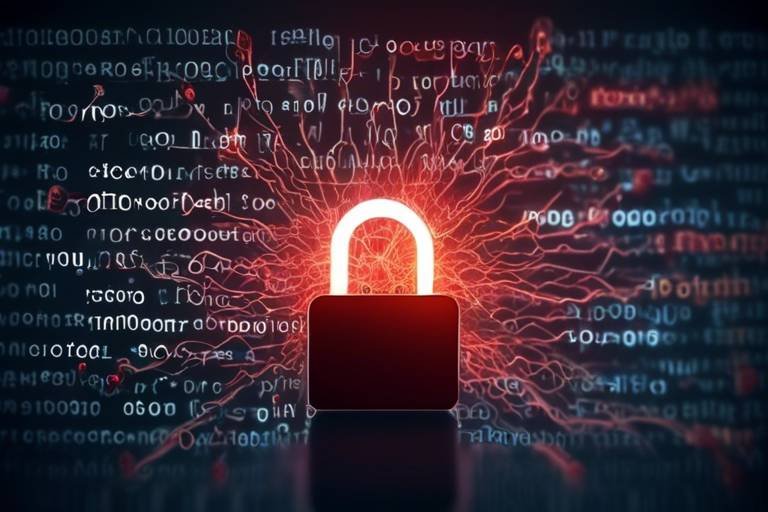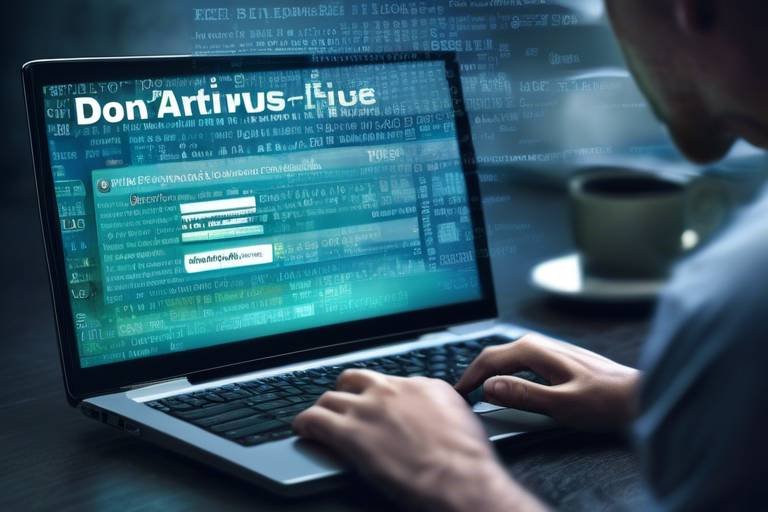Cybersecurity Lessons to Learn From Attackers
In today's digital landscape, the threat of cyberattacks looms larger than ever. Organizations across the globe are constantly on high alert, trying to safeguard their sensitive data and critical assets. But what if the key to enhancing your cybersecurity lies not just in defense mechanisms, but in understanding the very tactics used by attackers? By examining the strategies employed by cybercriminals, we can uncover vital lessons that can help bolster our defenses. This article delves into the intricate world of cyber threats, offering insights that can empower organizations to better protect themselves and their valuable information.
Cybercriminals are not static; they are dynamic, constantly evolving their tactics to exploit new vulnerabilities. Understanding these changing tactics is crucial for any organization aiming to stay one step ahead. Recent trends indicate that attackers are employing increasingly sophisticated methods, leveraging technology and social engineering to infiltrate systems. For instance, the rise of artificial intelligence has enabled attackers to automate their processes, making it easier for them to launch attacks at scale. The key takeaway here is that organizations must remain vigilant and adaptive, regularly updating their security protocols to counter these evolving threats.
Phishing attacks are often the first point of entry for cybercriminals, making them a critical area for organizations to address. These attacks can take many forms, from generic emails to highly targeted spear phishing attempts. The common thread is the manipulation of human psychology to trick individuals into divulging sensitive information. To combat this, organizations need to invest in employee education, ensuring that everyone is aware of the risks and knows how to recognize potential threats. By fostering a culture of awareness, companies can significantly reduce their vulnerability to these attacks.
Phishing attacks can be categorized into several types, each with its own targets and methods. Here are a few notable ones:
- Generic Phishing: Mass emails sent to a wide audience, hoping to catch a few unsuspecting victims.
- Spear Phishing: Targeted attacks aimed at specific individuals or organizations, often using personalized information.
- Whaling: A form of spear phishing that targets high-profile individuals, such as executives or key decision-makers.
Understanding these variations is essential for tailoring defenses effectively. Organizations must recognize that a one-size-fits-all approach will not suffice; instead, they should develop strategies that specifically address the types of phishing attacks they are most likely to encounter.
Identifying phishing attempts is a crucial skill for every employee. There are several key indicators that can help in spotting these malicious messages:
- Unusual sender addresses or domains.
- Generic greetings like "Dear Customer" instead of personalized salutations.
- Urgent language that creates a sense of panic or fear.
- Links that redirect to suspicious or unfamiliar websites.
By training employees to recognize these signs, organizations can empower them to act as the first line of defense against phishing attacks.
Implementing preventive measures can significantly reduce the risk of falling victim to phishing attacks. Strategies such as multi-factor authentication add an extra layer of security, ensuring that even if credentials are compromised, unauthorized access is still prevented. Additionally, regular security training sessions can keep employees informed about the latest phishing tactics and reinforce the importance of vigilance. Organizations should also consider employing advanced email filtering solutions to catch suspicious messages before they reach inboxes.
Social engineering is a powerful tool in the arsenal of cybercriminals, relying on manipulation and deception rather than technical prowess. By exploiting human emotions—such as fear, trust, or urgency—attackers can gain unauthorized access to sensitive information. Organizations need to recognize the psychological aspects of these attacks and incorporate this understanding into their training programs. By fostering a culture of skepticism and critical thinking, businesses can better equip their employees to resist social engineering tactics.
Ransomware attacks have surged in recent years, crippling organizations worldwide and causing significant financial losses. Understanding the mechanics of ransomware is essential for effective defense. Typically, a ransomware attack begins with infiltration, often through phishing emails or unpatched software vulnerabilities. Once inside, the malware encrypts critical files, rendering them inaccessible until a ransom is paid. This vicious cycle highlights the need for robust backup solutions and incident response plans to mitigate the impact of such attacks.
To effectively combat ransomware, organizations must understand its lifecycle:
- Infiltration: The initial breach, often through phishing or exploiting vulnerabilities.
- Encryption: The malware encrypts files, locking users out of their data.
- Ransom Demand: Attackers demand payment in exchange for the decryption key.
By comprehensively understanding this process, organizations can develop targeted strategies to prevent and respond to ransomware threats.
Having a well-defined response plan is critical in the event of a ransomware attack. Key steps include:
- Isolating infected systems to prevent further spread.
- Assessing the extent of the damage and determining whether to pay the ransom.
- Communicating with stakeholders and law enforcement, if necessary.
- Restoring data from backups and reinforcing security measures to prevent future attacks.
By preparing for the worst, organizations can minimize damage and recover more swiftly from ransomware incidents.
A robust cybersecurity culture is essential for organizational resilience. It’s not just about implementing the latest technology; it’s about fostering a mindset of security awareness among employees. Organizations should encourage open discussions about cybersecurity, making it a part of the daily routine rather than a once-a-year training session. When employees feel invested in the security of their organization, they are more likely to remain vigilant and proactive in preventing cyber threats.
Q: What is the most common type of cyberattack?
A: Phishing attacks are the most common, often serving as the entry point for other types of attacks.
Q: How can I protect my organization from ransomware?
A: Regular backups, employee training, and strong security protocols are essential for protecting against ransomware.
Q: What role does employee training play in cybersecurity?
A: Employee training is crucial; it helps individuals recognize threats and respond appropriately, reducing the likelihood of successful attacks.
Q: How often should organizations update their cybersecurity measures?
A: Organizations should regularly review and update their cybersecurity measures, ideally on a quarterly basis or whenever new threats emerge.

The Evolving Tactics of Cybercriminals
In today's digital landscape, the tactics employed by cybercriminals are constantly evolving, making it imperative for organizations to stay one step ahead. Cybercriminals are not just tech-savvy individuals; they are increasingly organized and strategic, often resembling well-oiled machines that adapt and learn from their past attacks. It's like a game of chess, where every move counts and the stakes are high. Understanding these changing tactics is crucial for organizations that aim to protect their sensitive data and maintain their reputation.
Recent trends in cyberattacks reveal a shift towards more sophisticated methods. Cybercriminals are leveraging advanced technologies like artificial intelligence and machine learning to enhance their attack strategies. This means that traditional defenses may no longer be sufficient. For instance, they might employ automated tools to scan for vulnerabilities in systems, making it easier for them to identify weak points to exploit. The use of these technologies allows attackers to execute attacks at a scale and speed that were previously unimaginable.
Moreover, the rise of ransomware as a service has democratized cybercrime, enabling even those with minimal technical skills to launch devastating attacks. This shift has led to a surge in attacks targeting not only large corporations but also small businesses and individuals. The attackers often use a combination of tactics, including social engineering and phishing, to gain access to systems before deploying ransomware. It's like a thief who not only picks the lock but also distracts the homeowner to sneak in unnoticed.
Another significant trend is the exploitation of remote work environments. As more organizations embrace remote work, attackers have seized the opportunity to target vulnerabilities in home networks and personal devices. This new attack surface presents unique challenges for cybersecurity teams. For example, attackers may use malicious links sent via email or social media to trick employees into downloading malware onto their devices. This highlights the importance of ensuring that cybersecurity measures extend beyond the office walls.
To effectively combat these evolving tactics, organizations must adopt a proactive approach. This includes regularly updating and patching software, conducting vulnerability assessments, and implementing robust security protocols. Additionally, fostering a culture of cybersecurity awareness among employees is essential. Training programs that educate staff on recognizing potential threats and understanding the importance of cybersecurity can be invaluable. It’s akin to teaching someone how to read the warning signs of a storm before it hits.
In conclusion, the tactics of cybercriminals are not static; they are dynamic and constantly evolving. Organizations must remain vigilant and adaptable to these changes to safeguard their assets. By understanding the strategies employed by attackers, businesses can implement more effective defenses and create a cybersecurity culture that prioritizes awareness and preparedness. Remember, in the world of cybersecurity, knowledge truly is power.

Phishing: The Gateway Attack
Phishing is often referred to as the gateway attack in the world of cybersecurity, and for good reason. It serves as the entry point for many cybercriminals looking to exploit organizations and individuals alike. In essence, phishing involves tricking victims into revealing sensitive information, such as usernames, passwords, or credit card details, by masquerading as a trustworthy entity in electronic communications. The art of deception is at the heart of phishing, making it a potent weapon in the arsenal of cyber attackers.
One of the most alarming aspects of phishing is its ubiquity. Cybercriminals have evolved their techniques over the years, leveraging social media, email, and even SMS to reach their targets. The rise of remote work has only exacerbated this issue, as employees often find themselves navigating a digital landscape filled with potential threats. For organizations, the challenge lies not only in identifying these attacks but also in creating a robust defense mechanism that empowers employees to recognize and report phishing attempts.
To effectively combat phishing, organizations must first understand the various forms it can take. From spear phishing, which targets specific individuals within an organization, to whaling, aimed at high-profile targets like executives, the landscape is diverse. Each type of phishing attack has its own unique characteristics and requires tailored responses. For example:
| Type of Phishing | Description | Target |
|---|---|---|
| Spear Phishing | Highly targeted emails that appear to come from a trusted source | Specific individuals or organizations |
| Whaling | A form of spear phishing targeting high-profile individuals | Executives or senior management |
| Clone Phishing | A legitimate email is used to create a fake version | General users within an organization |
Recognizing phishing attempts is crucial in prevention. Employees need to be trained to look for key indicators, such as:
- Unusual sender addresses
- Generic greetings instead of personalized messages
- Urgent calls to action, such as "verify your account immediately"
- Suspicious links or attachments
By fostering a culture of vigilance and security awareness, organizations can significantly reduce the risk of falling victim to phishing attacks. Regular training sessions can help employees stay informed about the latest phishing tactics and enhance their ability to identify potential threats. Additionally, implementing preventive measures like multi-factor authentication can provide an extra layer of security, ensuring that even if credentials are compromised, unauthorized access can still be thwarted.
In conclusion, phishing may be the gateway attack, but it doesn't have to be the end of the road for organizations. By understanding the various forms of phishing, recognizing the signs, and implementing effective training and security measures, businesses can fortify their defenses and protect their valuable assets. Remember, in the digital age, a well-informed employee is your best line of defense.
Q: What is phishing?
A: Phishing is a cyber attack that involves tricking individuals into revealing sensitive information by pretending to be a trustworthy entity, often through email or other electronic communications.
Q: How can I recognize a phishing email?
A: Look for unusual sender addresses, generic greetings, urgent requests, and suspicious links or attachments.
Q: What should I do if I suspect a phishing attempt?
A: Report the email to your IT department or security team, and do not click on any links or download attachments.
Q: Can multi-factor authentication help prevent phishing attacks?
A: Yes, multi-factor authentication adds an extra layer of security, making it more difficult for attackers to gain unauthorized access even if they obtain your credentials.

Types of Phishing Attacks
Phishing attacks come in various shapes and sizes, each designed to deceive unsuspecting victims into revealing sensitive information, such as passwords, credit card numbers, and other personal data. Understanding these different types of phishing attacks is crucial for organizations looking to bolster their defenses. Let's dive into some of the most common forms of phishing that cybercriminals employ.
One of the most prevalent types is spear phishing. Unlike generic phishing attempts that cast a wide net, spear phishing is highly targeted. Attackers often conduct extensive research on their victims, tailoring their messages to make them appear legitimate. For instance, an attacker might impersonate a colleague or a trusted business partner, making it more likely that the victim will fall for the ruse. Because of this personalized approach, spear phishing can be particularly effective and dangerous.
Another notorious form is whaling. This method targets high-profile individuals, such as executives or key decision-makers within an organization. Whaling attacks are like spear phishing but on a larger scale, often involving more sophisticated tactics and more significant stakes. For example, an attacker might send an email that looks like it’s from a financial institution, requesting urgent action to avoid severe consequences. The stakes are high, and the pressure can lead to hasty decisions, making whaling a formidable threat.
In addition to these targeted attacks, there are also clone phishing attacks. In this scenario, attackers take a previously delivered legitimate email, replace the original attachment or link with a malicious one, and resend it to the victim. The email appears to come from a trusted source, often leading the victim to believe they are simply re-engaging with a prior conversation. This tactic exploits the victim's trust and familiarity, making it a clever and insidious method.
Moreover, there’s vishing and smishing, which are variations of phishing that utilize voice calls and SMS messages, respectively. Vishing involves phone calls where attackers impersonate legitimate organizations, aiming to extract sensitive information. Meanwhile, smishing uses text messages to lure victims into clicking on malicious links or providing personal information. Both methods rely heavily on social engineering, exploiting human psychology to achieve their goals.
To effectively combat these diverse phishing tactics, organizations must implement comprehensive training programs that educate employees about the various forms of phishing attacks. Regular simulations and updates on the latest phishing trends can significantly enhance awareness and preparedness. By fostering a culture of vigilance, companies can turn their employees into a robust line of defense against these deceptive strategies.
| Type of Phishing | Description | Target |
|---|---|---|
| Spear Phishing | Targeted attacks using personalized messages. | Individuals or specific groups. |
| Whaling | Attacks aimed at high-profile targets like executives. | Top management and decision-makers. |
| Clone Phishing | Re-sending a modified legitimate email. | Previous email recipients. |
| Vishing | Voice phishing via phone calls. | Individuals or businesses. |
| Smishing | SMS phishing using text messages. | Mobile phone users. |

Recognizing Phishing Attempts
In today's digital landscape, recognizing phishing attempts is not just a skill—it's a necessity. Cybercriminals are becoming increasingly sophisticated, using a variety of tactics to deceive unsuspecting users. These phishing attempts often masquerade as legitimate communications, making it crucial for individuals and organizations to be vigilant. So, how can you spot these deceitful messages before they wreak havoc?
One of the most effective ways to recognize phishing attempts is by scrutinizing the sender's email address. Often, attackers will use addresses that look similar to legitimate ones but have subtle differences. For instance, a phishing email might come from support@yourbank.com instead of the official support@yourbank.co. Always double-check the domain name and look for any unusual characters or misspellings.
Another common tactic used in phishing is the creation of a sense of urgency. Emails that claim your account will be suspended unless you take immediate action are designed to provoke a quick response without careful consideration. Remember, legitimate organizations rarely pressure you to act immediately. If you encounter such messages, take a step back and verify through official channels.
Furthermore, be on the lookout for generic greetings in emails. Phishing attempts often address you with vague terms like "Dear Customer" instead of your actual name. Legitimate companies usually personalize their communications based on their records. If an email feels impersonal, it may be a red flag.
Additionally, phishing emails frequently contain poor grammar and spelling mistakes. While we all make typos, a professional organization is less likely to send out communications filled with errors. If you notice multiple mistakes, it’s a good idea to treat the email with suspicion.
Lastly, always be cautious with links and attachments. Hover over any links to see the actual URL before clicking. If the link looks suspicious or doesn’t match the context of the email, don’t click it! Similarly, avoid downloading attachments from unknown sources, as they may contain malware designed to compromise your system.
In summary, recognizing phishing attempts involves a combination of vigilance, knowledge, and skepticism. By training employees to identify these signs, organizations can significantly reduce their risk of falling victim to phishing scams. Remember, when in doubt, always verify through official sources before taking action. Stay safe!
- What should I do if I suspect a phishing attempt? If you believe you've received a phishing email, do not click any links or download attachments. Report it to your IT department or use the phishing report feature provided by your email service.
- Can phishing emails be identified by their appearance? While some phishing emails may appear professional, many contain telltale signs like poor grammar, generic greetings, and suspicious links. Always be cautious.
- How can I educate my team about phishing? Regular training sessions, simulated phishing exercises, and sharing real-world examples can help raise awareness and prepare your team to recognize phishing attempts.

Preventive Measures Against Phishing
Phishing attacks can feel like a never-ending battle, but fear not! There are several preventive measures that organizations can implement to significantly reduce their risks. First and foremost, multi-factor authentication (MFA) is a game changer. By requiring a second form of verification, such as a text message code or an authentication app, even if a user's password is compromised, attackers will still struggle to gain access. This simple step can drastically enhance security.
Another vital strategy is to conduct regular security training for employees. It's not enough to set it and forget it; ongoing education keeps security at the forefront of everyone’s mind. Training sessions should cover the latest phishing techniques, how to spot suspicious emails, and the importance of reporting these attempts. For instance, employees can be taught to look out for generic greetings, urgent language, and mismatched URLs. By familiarizing them with these tactics, organizations empower their workforce to act as the first line of defense.
Additionally, organizations can implement email filtering solutions that automatically detect and block potential phishing attempts before they reach inboxes. These tools use advanced algorithms to analyze incoming emails for signs of malicious intent. It’s like having a security guard at the entrance of your digital building, turning away anyone who doesn’t belong.
Moreover, regularly updating software is crucial. Cybercriminals often exploit vulnerabilities in outdated systems. By keeping software up to date, organizations can patch security holes and make it harder for attackers to gain a foothold. This is akin to reinforcing the locks on your doors and windows; it adds an extra layer of protection against intruders.
Lastly, organizations should develop a clear incident response plan for phishing attacks. This plan should outline the steps to take if an employee clicks on a phishing link or provides sensitive information. Quick action can mitigate damages, so knowing who to contact and what steps to follow can save the day. Think of it as having a fire drill; being prepared can make all the difference when the heat is on.
By implementing these preventive measures, organizations can create a robust defense against phishing attacks, turning their employees into vigilant guardians of sensitive information.
- What is phishing? Phishing is a cyber attack where attackers impersonate legitimate entities to trick individuals into providing sensitive information.
- How can I recognize a phishing email? Look for generic greetings, urgent requests, and mismatched URLs. Always verify the sender's email address.
- What should I do if I suspect a phishing attempt? Report it to your IT department or security team immediately and avoid clicking any links or downloading attachments.
- Is multi-factor authentication really effective? Yes, MFA adds an extra layer of security, making it much harder for attackers to gain unauthorized access.

The Role of Social Engineering
In the realm of cybersecurity, social engineering stands out as one of the most insidious tactics employed by cybercriminals. Unlike traditional hacking methods that rely on technical skills, social engineering exploits human psychology, manipulating individuals into divulging confidential information or granting unauthorized access. Imagine a skilled con artist who can charm their way into a bank, bypassing security measures simply by engaging in conversation. This is the essence of social engineering—it's all about the art of deception.
Cybercriminals often rely on psychological triggers, such as fear, urgency, and curiosity, to prompt quick reactions from their targets. For instance, an employee might receive an email that appears to be from their IT department, claiming that their account has been compromised and urging them to click on a link to reset their password immediately. The pressure to act quickly can cloud judgment, leading to disastrous consequences. This tactic not only highlights the vulnerability of human nature but also underscores the necessity for organizations to prioritize security awareness training.
Furthermore, social engineering attacks can take various forms, each designed to exploit specific weaknesses. Here are some common types:
- Phishing: Deceptive emails that trick users into providing sensitive information.
- Spear Phishing: Targeted attacks aimed at specific individuals or organizations, often using personal information to increase credibility.
- Pretexting: Creating a fabricated scenario to obtain confidential information.
- Baiting: Offering something enticing, such as free software, to lure individuals into compromising their security.
Recognizing the signs of social engineering is crucial for any organization. Employees should be trained to question unexpected requests for sensitive information, especially when they come from unfamiliar sources. Creating a culture of skepticism can serve as a powerful defense mechanism. For example, if an employee receives a suspicious email, they should be encouraged to verify the sender's identity through a different communication channel, such as a phone call.
Moreover, organizations can implement several strategies to mitigate the risks associated with social engineering:
- Regular Training: Conduct ongoing training sessions to keep employees informed about the latest social engineering tactics.
- Simulated Attacks: Run mock phishing campaigns to test employees' responses and reinforce learning.
- Clear Reporting Procedures: Establish a straightforward process for employees to report suspicious activities or communications.
Ultimately, the key to defending against social engineering lies in fostering a culture of awareness and vigilance. By empowering employees with knowledge and encouraging them to think critically about the information they encounter, organizations can significantly reduce their vulnerability to these deceptive tactics. Remember, in the world of cybersecurity, a well-informed employee is your first line of defense.
Q: What is social engineering in cybersecurity?
A: Social engineering is a manipulation technique that exploits human psychology to gain confidential information or access to systems.
Q: How can I recognize a social engineering attack?
A: Look for unexpected requests for sensitive information, urgency in communication, or anything that seems out of the ordinary.
Q: What steps can organizations take to prevent social engineering attacks?
A: Organizations should conduct regular training, run simulated attacks, and establish clear reporting procedures for suspicious activities.

Ransomware: A Growing Threat
In today's digital landscape, ransomware has emerged as one of the most menacing threats organizations face. With its ability to cripple entire networks and demand hefty ransoms, the impact of these attacks can be devastating. Imagine waking up to find your entire business paralyzed, unable to access critical data, with a ticking clock counting down to when the attackers will delete your files forever. This is the harsh reality for many organizations that fall victim to ransomware. As we delve deeper into this subject, it becomes clear that understanding the mechanics of ransomware is not just beneficial—it's essential for survival in the modern business environment.
The surge in ransomware attacks can be attributed to several factors. Firstly, the increasing reliance on digital infrastructure has created a larger attack surface for cybercriminals. Secondly, the rise of cryptocurrencies has made it easier for attackers to receive payments anonymously. This combination of factors has led to a significant rise in ransomware incidents, with attackers continually refining their methods to exploit vulnerabilities in systems. According to recent statistics, ransomware attacks have increased by over 300% in the past year alone, highlighting the urgency for organizations to bolster their defenses.
Understanding the mechanics of ransomware is crucial for organizations aiming to protect themselves. Ransomware typically follows a lifecycle that includes several stages: infiltration, encryption, and ransom demand. During the infiltration phase, attackers often exploit vulnerabilities in software, use phishing tactics to trick users into downloading malicious files, or leverage remote desktop protocol (RDP) vulnerabilities to gain access to a network. Once inside, they begin the encryption process, locking users out of their files and systems. Finally, the attackers present a ransom demand, often threatening to leak sensitive data if the ransom is not paid. This cycle can occur in a matter of hours, leaving organizations scrambling to respond.
To combat the growing threat of ransomware, organizations must adopt comprehensive response strategies. Here are some key steps to consider:
- Regular Backups: Ensure that data is backed up regularly and stored in a secure location, separate from the main network. This allows for recovery without paying the ransom.
- Incident Response Plan: Develop and maintain an incident response plan that outlines the steps to take in the event of a ransomware attack, including communication strategies and recovery procedures.
- Employee Training: Conduct regular training sessions for employees to recognize phishing attempts and other social engineering tactics that could lead to ransomware infections.
- System Updates: Keep all software and systems up to date with the latest security patches to close vulnerabilities that attackers could exploit.
As ransomware continues to evolve, so too must our defenses. It's not just about having the latest technology; it's about fostering a culture of cybersecurity awareness across the organization. Employees should feel empowered to report suspicious activities and understand the importance of their role in safeguarding company data. Remember, in the world of cybersecurity, everyone is a frontline defender.
1. What should I do if my organization is attacked by ransomware?
First, isolate the infected systems to prevent the spread of the malware. Then, consult your incident response plan and contact cybersecurity professionals for assistance. It's crucial to assess whether you can recover your data from backups before considering paying the ransom.
2. Can paying the ransom guarantee the return of my data?
There is no guarantee that paying the ransom will result in the recovery of your data. In many cases, victims find that the attackers do not provide the decryption keys or that the keys do not work. Additionally, paying the ransom may encourage future attacks.
3. How can I prevent ransomware attacks?
Prevention starts with a multi-layered approach that includes regular data backups, employee training, timely software updates, and a robust incident response plan. Implementing strong security measures can significantly reduce the risk of falling victim to ransomware.

Understanding Ransomware Mechanics
Ransomware has become a household name in the cybersecurity world, and for good reason. It’s not just a buzzword; it’s a sophisticated and malicious form of malware that can bring organizations to their knees. To effectively defend against ransomware, understanding its mechanics is crucial. So, how does ransomware actually work? Let’s break it down.
Typically, a ransomware attack begins with an infiltration phase. This is where the attacker gains access to the target’s system. They might achieve this through various means, such as phishing emails, malicious downloads, or exploiting software vulnerabilities. Once inside, the attacker will often conduct reconnaissance to identify valuable data and the best way to execute their attack. It’s like a thief casing a house before deciding which window to break in through.
Next comes the encryption phase. This is where the real damage occurs. The ransomware encrypts files on the infected system, making them inaccessible to the user. Imagine having your entire digital library locked away with a key you can’t find. The attacker then presents a ransom note, demanding payment—often in cryptocurrency—before they will provide the decryption key. This note typically includes a countdown timer, adding pressure to the victim to comply quickly.
Here’s a simple breakdown of the ransomware attack lifecycle:
| Phase | Description |
|---|---|
| Infiltration | Gaining unauthorized access to the target system. |
| Reconnaissance | Identifying valuable data and system vulnerabilities. |
| Encryption | Locking files and demanding ransom for decryption. |
| Payment | Victim pays the ransom, hoping to regain access. |
| Recovery | Attempting to restore files, either through decryption or backups. |
After the ransom is paid, many victims hope for a happy ending. However, it’s essential to note that paying the ransom does not guarantee that the attacker will actually provide the decryption key. In fact, some victims have reported that even after paying, they were left with encrypted files, adding insult to injury. This is a harsh reminder that the best defense is always prevention.
To enhance understanding, let’s also look at some common types of ransomware:
- Crypto Ransomware: Encrypts files and demands payment for decryption.
- Locker Ransomware: Locks users out of their devices, making it impossible to access data.
- Scareware: Tricks users into believing their system is infected, demanding payment to fix it.
In conclusion, understanding the mechanics of ransomware is not just about knowing how it operates; it's about empowering organizations to put preventive measures in place. By recognizing how attackers infiltrate systems, the methods they use to encrypt data, and the nature of their ransom demands, organizations can develop robust defenses and response strategies to mitigate the risks associated with ransomware attacks.
Q: What should I do if I fall victim to a ransomware attack?
A: First, disconnect your device from the internet to prevent further spread. Then, report the incident to your IT department or a cybersecurity professional. Avoid paying the ransom as it does not guarantee recovery.
Q: How can I prevent ransomware attacks?
A: Regularly update your software, use strong passwords, and educate employees about phishing and other attack vectors. Implementing regular backups can also help in recovery.
Q: Is it safe to pay the ransom?
A: Paying the ransom is risky and does not guarantee that you will regain access to your files. It may also encourage further attacks.

Response Strategies for Ransomware Attacks
When faced with a ransomware attack, organizations must act swiftly and strategically to minimize damage and recover effectively. The first step is to establish a comprehensive response plan before an attack occurs. This plan should outline clear roles and responsibilities for team members, ensuring that everyone knows what to do in the heat of the moment. Think of it as a fire drill; practicing your response can mean the difference between chaos and control.
One crucial aspect of a robust response strategy is the immediate isolation of affected systems. This prevents the ransomware from spreading further across the network. Imagine a wildfire; if you can contain it quickly, you can save the forest from total destruction. Disconnecting infected devices from the network can halt the attack's progression, giving your IT team a fighting chance to assess and address the situation.
Next, organizations should conduct a thorough investigation to understand the nature of the attack. This involves identifying how the ransomware entered the system, what vulnerabilities were exploited, and which data has been compromised. Documenting these findings is essential, as it not only aids in recovery but also helps in fortifying defenses against future attacks. A detailed incident report can serve as a valuable resource for improving your cybersecurity posture.
After isolating the systems and understanding the attack, the next step is to restore data from backups. Regularly backing up data is like having an insurance policy; it provides a safety net in case of emergencies. Ensure that backups are stored securely and are not connected to the main network, as this can prevent them from being compromised during an attack. If backups are intact, organizations can often recover without paying the ransom, which is a significant advantage.
In the unfortunate event that no viable backup exists, organizations must weigh the risks of paying the ransom. While it may seem like a quick fix, paying does not guarantee that the attackers will provide the decryption key or that they won’t target you again. It’s like feeding a stray dog; it might come back for more. Therefore, it's crucial to consider all options carefully and consult with cybersecurity professionals before making this decision.
Finally, after addressing the immediate crisis, organizations should focus on post-incident recovery and improvement. This includes reviewing the response to the attack, identifying what worked and what didn’t, and updating the incident response plan accordingly. Continuous training for employees on recognizing phishing attempts and other attack vectors is also vital. Remember, in cybersecurity, staying static is not an option; the landscape is constantly evolving, and so must your defenses.
- What should I do first if my organization is hit by ransomware?
Isolate the infected systems immediately to prevent further spread. - Should I pay the ransom?
Consider the risks carefully; paying does not guarantee recovery and may encourage future attacks. - How can I prevent ransomware attacks?
Regularly back up data, educate employees about phishing, and maintain updated security protocols. - What are the signs of a ransomware attack?
Unusual file extensions, ransom notes on screens, and inability to access files are common indicators.

Building a Strong Cybersecurity Culture
In today’s digital landscape, where cyber threats loom larger than ever, organizations must prioritize the establishment of a strong cybersecurity culture. But what does that really mean? Imagine a fortress where every guard is vigilant, every wall is fortified, and every citizen knows how to respond to an intruder. This analogy perfectly encapsulates the essence of a robust cybersecurity culture. It’s not just about having the latest technology or software; it’s about instilling a mindset of security awareness and vigilance among all employees.
To build this culture, organizations need to start at the top. Leadership must actively promote cybersecurity as a core value, integrating it into the company’s mission and everyday practices. When executives prioritize security, it sends a clear message: cybersecurity is everyone’s responsibility. This top-down approach fosters an environment where employees feel empowered to take action and report suspicious activities without fear of retribution.
Education plays a pivotal role in cultivating a cybersecurity-conscious workforce. Regular training sessions should be held to keep employees informed about the latest threats and best practices. For instance, consider implementing a cybersecurity awareness program that covers:
- Identifying phishing attempts
- Understanding the importance of strong passwords
- Recognizing the signs of social engineering
- Best practices for data protection
Moreover, organizations should create an open dialogue around cybersecurity. Encourage employees to share their experiences and concerns related to security. This can be facilitated through regular meetings, newsletters, or even dedicated channels in communication platforms. By fostering this environment of transparency, employees are more likely to report potential threats and collaborate on solutions.
Another essential aspect of building a strong cybersecurity culture is the implementation of policies and procedures. Clear guidelines should be established regarding acceptable use of technology, data handling, and incident reporting. Employees should be well-versed in these policies, and regular assessments should be conducted to ensure compliance. An effective way to reinforce these policies is through gamification—turning security training into engaging quizzes or challenges that reward participation and knowledge.
Lastly, organizations must recognize and celebrate those who exemplify good cybersecurity practices. Acknowledging employees who report threats or adhere to security protocols can motivate others to follow suit. This not only reinforces positive behavior but also shows that the organization values security as a vital component of its success.
In summary, building a strong cybersecurity culture is not a one-time effort but an ongoing commitment. It requires the collaboration of all employees, from the C-suite to entry-level positions. By prioritizing education, communication, and recognition, organizations can create a resilient workforce that stands guard against cyber threats.
Q: Why is a cybersecurity culture important?
A: A strong cybersecurity culture helps organizations mitigate risks by ensuring that all employees are aware of potential threats and know how to respond effectively.
Q: How often should cybersecurity training be conducted?
A: Organizations should aim for at least quarterly training sessions, with additional updates as new threats emerge.
Q: What role do employees play in cybersecurity?
A: Employees are the first line of defense against cyber threats. Their awareness and vigilance can significantly reduce the likelihood of successful attacks.
Q: Can gamification enhance cybersecurity training?
A: Yes! Gamification makes training more engaging, encouraging participation and retention of information.
Frequently Asked Questions
- What are the most common types of cyberattacks?
The most common types of cyberattacks include phishing, ransomware, and social engineering. Phishing attacks often trick users into revealing sensitive information, while ransomware locks organizations out of their data until a ransom is paid. Social engineering manipulates individuals to gain unauthorized access.
- How can organizations protect themselves from phishing attacks?
Organizations can protect themselves from phishing attacks by implementing multi-factor authentication, conducting regular security training for employees, and using email filtering tools. It's also essential to encourage employees to recognize suspicious emails and report them promptly.
- What is the role of social engineering in cyberattacks?
Social engineering plays a significant role in cyberattacks as it exploits human psychology rather than technical vulnerabilities. Attackers may use tactics such as impersonation or creating a sense of urgency to manipulate individuals into providing sensitive information or access.
- What should an organization do if it falls victim to a ransomware attack?
If an organization falls victim to a ransomware attack, it should immediately isolate affected systems, notify law enforcement, and implement its incident response plan. Regular backups and a well-prepared recovery strategy can help mitigate the damage and restore operations more quickly.
- How can a strong cybersecurity culture benefit an organization?
A strong cybersecurity culture benefits an organization by fostering awareness and proactive behavior among employees regarding security practices. When employees understand the importance of cybersecurity, they are more likely to follow protocols and report potential threats, ultimately enhancing the organization's overall security posture.



















